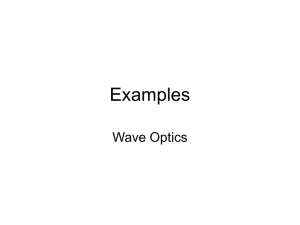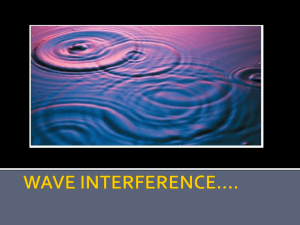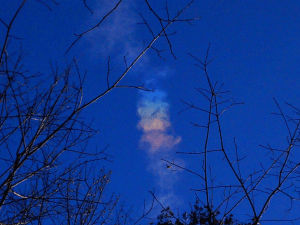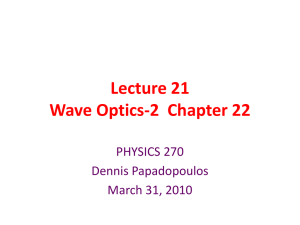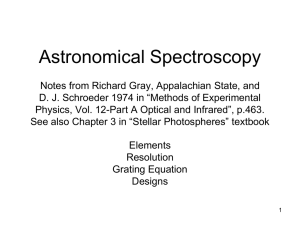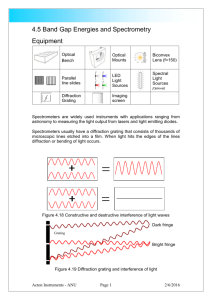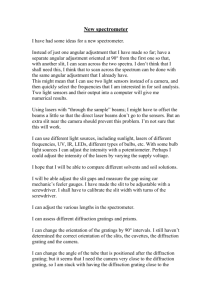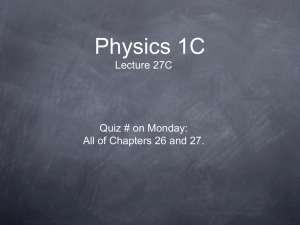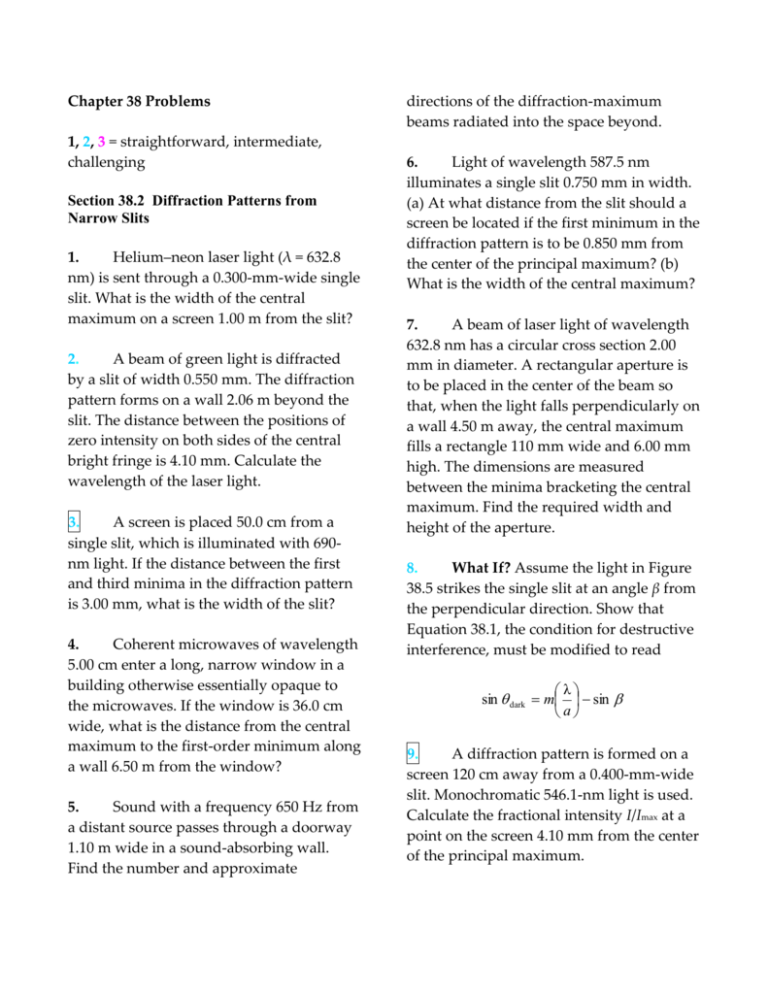
Chapter 38 Problems
1, 2, 3 = straightforward, intermediate,
challenging
Section 38.2 Diffraction Patterns from
Narrow Slits
1.
Helium–neon laser light (λ = 632.8
nm) is sent through a 0.300-mm-wide single
slit. What is the width of the central
maximum on a screen 1.00 m from the slit?
2.
A beam of green light is diffracted
by a slit of width 0.550 mm. The diffraction
pattern forms on a wall 2.06 m beyond the
slit. The distance between the positions of
zero intensity on both sides of the central
bright fringe is 4.10 mm. Calculate the
wavelength of the laser light.
3.
A screen is placed 50.0 cm from a
single slit, which is illuminated with 690nm light. If the distance between the first
and third minima in the diffraction pattern
is 3.00 mm, what is the width of the slit?
4.
Coherent microwaves of wavelength
5.00 cm enter a long, narrow window in a
building otherwise essentially opaque to
the microwaves. If the window is 36.0 cm
wide, what is the distance from the central
maximum to the first-order minimum along
a wall 6.50 m from the window?
5.
Sound with a frequency 650 Hz from
a distant source passes through a doorway
1.10 m wide in a sound-absorbing wall.
Find the number and approximate
directions of the diffraction-maximum
beams radiated into the space beyond.
6.
Light of wavelength 587.5 nm
illuminates a single slit 0.750 mm in width.
(a) At what distance from the slit should a
screen be located if the first minimum in the
diffraction pattern is to be 0.850 mm from
the center of the principal maximum? (b)
What is the width of the central maximum?
7.
A beam of laser light of wavelength
632.8 nm has a circular cross section 2.00
mm in diameter. A rectangular aperture is
to be placed in the center of the beam so
that, when the light falls perpendicularly on
a wall 4.50 m away, the central maximum
fills a rectangle 110 mm wide and 6.00 mm
high. The dimensions are measured
between the minima bracketing the central
maximum. Find the required width and
height of the aperture.
8.
What If? Assume the light in Figure
38.5 strikes the single slit at an angle β from
the perpendicular direction. Show that
Equation 38.1, the condition for destructive
interference, must be modified to read
λ
sin dark m sin
a
9.
A diffraction pattern is formed on a
screen 120 cm away from a 0.400-mm-wide
slit. Monochromatic 546.1-nm light is used.
Calculate the fractional intensity I/Imax at a
point on the screen 4.10 mm from the center
of the principal maximum.
10.
Coherent light of wavelength 501.5
nm is sent through two parallel slits in a
large flat wall. Each slit is 0.700 μm wide.
Their centers are 2.80 μm apart. The light
then falls on a semicylindrical screen, with
its axis at the midline between the slits. (a)
Predict the direction of each interference
maximum on the screen, as an angle away
from the bisector of the line joining the slits.
(b) Describe the pattern of light on the
screen, specifying the number of bright
fringes and the location of each. (c) Find the
intensity of light on the screen at the center
of each bright fringe, expressed as a fraction
of the light intensity Imax at the center of the
pattern.
Section 38.3 Resolution of Single-Slit and
Circular Apertures
11.
The pupil of a cat’s eye narrows to a
vertical slit of width 0.500 mm in daylight.
What is the angular resolution for
horizontally separated mice? Assume that
the average wavelength of the light is 500
nm.
12.
Find the radius a star image forms
on the retina of the eye if the aperture
diameter (the pupil) at night is 0.700 cm
and the length of the eye is 3.00 cm.
Assume the representative wavelength of
starlight in the eye is 500 nm.
13.
A helium–neon laser emits light that
has a wavelength of 632.8 nm. The circular
aperture through which the beam emerges
has a diameter of 0.500 cm. Estimate the
diameter of the beam 10.0 km from the
laser.
14.
You are vacationing in a
Wonderland populated by friendly elves
and a cannibalistic Cyclops that devours
physics students. The elves and the Cyclops
look precisely alike (everyone wears loose
jeans and sweatshirts) except that each elf
has two eyes, about 10.0 cm apart, and the
Cyclops—you guessed it—has only one eye
of about the same size as an elf’s. The elves
and the Cyclops are constantly at war with
each other, so they rarely sleep and all have
red eyes, predominantly reflecting light
with a wavelength of 660 nm. From what
maximum distance can you distinguish
between a friendly elf and the predatory
Cyclops? The air in Wonderland is always
clear. Dilated with fear, your pupils have a
diameter of 7.00 mm.
15.
Narrow, parallel, glowing gas-filled
tubes in a variety of colors form block
letters to spell out the name of a night club.
Adjacent tubes are all 2.80 cm apart. The
tubes forming one letter are filled with
neon and radiate predominantly red light
with a wavelength of 640 nm. For another
letter, the tubes emit predominantly violet
light at 440 nm. The pupil of a darkadapted viewer’s eye is 5.20 mm in
diameter. If she is in a certain range of
distances away, the viewer can resolve the
separate tubes of one color but not the
other. Which color is easier to resolve? The
viewer’s distance must be in what range for
her to resolve the tubes of only one color?
16.
On the night of April 18, 1775, a
signal was sent from the steeple of Old
North Church in Boston to Paul Revere,
who was 1.80 mi away: “One if by land,
two if by sea.” At what minimum
separation did the sexton have to set the
lanterns for Revere to receive the correct
message about the approaching British?
Assume that the patriot’s pupils had a
diameter of 4.00 mm at night and that the
lantern light had a predominant
wavelength of 580 nm.
17.
The Impressionist painter Georges
Seurat created paintings with an enormous
number of dots of pure pigment, each of
which was approximately 2.00 mm in
diameter. The idea was to have colors such
as red and green next to each other to form
a scintillating canvas (Fig. P38.17). Outside
what distance would one be unable to
discern individual dots on the canvas?
(Assume that λ = 500 nm and that the pupil
diameter is 4.00 mm.)
18.
A binary star system in the
constellation Orion has an angular
interstellar separation of 1.00 × 10–5 rad. If λ
= 500 nm, what is the smallest diameter the
telescope can have to just resolve the two
stars?
19.
A spy satellite can consist essentially
of a large-diameter concave mirror forming
an image on a digital-camera detector and
sending the picture to a ground receiver by
radio waves. In effect, it is an astronomical
telescope in orbit, looking down instead of
up. Can a spy satellite read a license plate?
Can it read the date on a dime? Argue for
your answers by making an order-ofmagnitude calculation, specifying the data
you estimate.
20.
A circular radar antenna on a Coast
Guard ship has a diameter of 2.10 m and
radiates at a frequency of 15.0 GHz. Two
small boats are located 9.00 km away from
the ship. How close together could the
boats be and still be detected as two
objects?
21.
Grote Reber was a pioneer in radio
astronomy. He constructed a radio
telescope with a 10.0-m-diameter receiving
dish. What was the telescope’s angular
resolution for 2.00-m radio waves?
SuperStock
Figure P38.17: Sunday Afternoon on the
Island of La Grande Jatte, by Georges Seurat.
22.
When Mars is nearest the Earth, the
distance separating the two planets is 88.6 ×
106 km. Mars is viewed through a telescope
whose mirror has a diameter of 30.0 cm. (a)
If the wavelength of the light is 590 nm,
what is the angular resolution of the
telescope? (b) What is the smallest distance
that can be resolved between two points on
Mars?
slits/cm, what are the wavelengths of the
light? (b) At what angles are these lines
found in the second-order spectrum?
Section 38.4 The Diffraction Grating
Note: In the following problems, assume
that the light is incident normally on the
gratings.
23.
White light is spread out into its
spectral components by a diffraction
grating. If the grating has 2 000 grooves per
centimeter, at what angle does red light of
wavelength 640 nm appear in first order?
24.
Light from an argon laser strikes a
diffraction grating that has 5 310 grooves
per centimeter. The central and firstorder
principal maxima are separated by 0.488 m
on a wall 1.72 m from the grating.
Determine the wavelength of the laser light.
25.
The hydrogen spectrum has a red
line at 656 nm and a blue line at 434 nm.
What are the angular separations between
these two spectral lines obtained with a
diffraction grating that has 4 500
grooves/cm?
26.
A helium–neon laser (λ = 632.8 nm)
is used to calibrate a diffraction grating. If
the first-order maximum occurs at 20.5°,
what is the spacing between adjacent
grooves in the grating?
27.
Three discrete spectral lines occur at
angles of 10.09°, 13.71°, and 14.77° in the
first-order spectrum of a grating
spectrometer. (a) If the grating has 3 660
28.
Show that, whenever white light is
passed through a diffraction grating of any
spacing size, the violet end of the
continuous visible spectrum in third order
always overlaps with red light at the other
end of the second-order spectrum.
29.
A diffraction grating of width 4.00
cm has been ruled with 3 000 grooves/cm.
(a) What is the resolving power of this
grating in the first three orders? (b) If two
monochromatic waves incident on this
grating have a mean wavelength of 400 nm,
what is their wavelength separation if they
are just resolved in the third order?
30.
The laser in a CD player must
precisely follow the spiral track, along
which the distance between one loop of the
spiral and the next is only about 1.25 μm. A
feedback mechanism lets the player know if
the laser drifts off the track, so that the
player can steer it back again. Figure P38.30
shows how a diffraction grating is used to
provide information to keep the beam on
track. The laser light passes through a
diffraction grating just before it reaches the
disk. The strong central maximum of the
diffraction pattern is used to read the
information in the track of pits. The two
first-order side maxima are used for
steering. The grating is designed so that the
first-order maxima fall on the flat surfaces
on both sides of the information track. Both
side beams are reflected into their own
detectors. As long as both beams are
reflecting from smooth nonpitted surfaces,
they are detected with constant high
intensity. If the main beam wanders off the
track, however, one of the side beams will
begin to strike pits on the information track
and the reflected light will diminish. This
change is used with an electronic circuit to
guide the beam back to the desired location.
Assume that the laser light has a
wavelength of 780 nm and that the
diffraction grating is positioned 6.90 μm
from the disk. Assume that the first-order
beams are to fall on the disk 0.400 μm on
either side of the information track. What
should be the number of grooves per
millimeter in the grating?
Figure P38.30
31.
A source emits 531.62-nm and
531.81-nm light. (a) What minimum
number of grooves is required for a grating
that resolves the two wavelengths in the
first-order spectrum? (b) Determine the slit
spacing for a grating 1.32 cm wide that has
the required minimum number of grooves.
32.
A diffraction grating has 4 200
rulings/cm. On a screen 2.00 m from the
grating, it is found that for a particular
order m, the maxima corresponding to two
closely spaced wavelengths of sodium
(589.0 nm and 589.6 nm) are separated by
1.59 mm. Determine the value of m.
33.
A grating with 250 grooves/mm is
used with an incandescent light source.
Assume the visible spectrum to range in
wavelength from 400 to 700 nm. In how
many orders can one see (a) the entire
visible spectrum and (b) the shortwavelength region?
34.
A wide beam of laser light with a
wavelength of 632.8 nm is directed through
several narrow parallel slits, separated by
1.20 mm, and falls on a sheet of
photographic film 1.40 m away. The
exposure time is chosen so that the film
stays unexposed everywhere except at the
central region of each bright fringe. (a) Find
the distance between these interference
maxima. The film is printed as a
transparency—it is opaque everywhere
except at the exposed lines. Next, the same
beam of laser light is directed through the
transparency and allowed to fall on a screen
1.40 m beyond. (b) Argue that several
narrow parallel bright regions, separated
by 1.20 mm, will appear on the screen, as
real images of the original slits. If at last the
screen is removed, light will diverge from
the images of the original slits with the
same reconstructed wave fronts as the
original slits produced. (Suggestion: You
may find it useful to draw diagrams similar
to Figure 38.16. A train of thought like this,
at a soccer game, led Dennis Gabor to the
invention of holography.)
Section 38.5 Diffraction of X-Rays by
Crystals
35.
Potassium iodide (KI) has the same
crystalline structure as NaCl, with atomic
planes separated by 0.353 nm. A
monochromatic x-ray beam shows a firstorder diffraction maximum when the
grazing angle is 7.60°. Calculate the x-ray
wavelength.
36.
A wavelength of 0.129 nm
characterizes Kα x-rays from zinc. When a
beam of these x-rays is incident on the
surface of a crystal whose structure is
similar to that of NaCl, a first-order
maximum is observed at 8.15°. Calculate
the interplanar spacing based on this
information.
37.
If the interplanar spacing of NaCl is
0.281 nm, what is the predicted angle at
which 0.140-nm x-rays are diffracted in a
first-order maximum?
38.
The first-order diffraction maximum
is observed at 12.6° for a crystal in which
the interplanar spacing is 0.240 nm. How
many other orders can be observed?
39.
In water of uniform depth, a wide
pier is supported on pilings in several
parallel rows 2.80 m apart. Ocean waves of
uniform wavelength roll in, moving in a
direction that makes an angle of 80.0° with
the rows of posts. Find the three longest
wavelengths of waves that will be strongly
reflected by the pilings.
Section 38.6 Polarization of Light Waves
Problem 34 in Chapter 34 can be
assigned with this section.
40.
Unpolarized light passes through
two polaroid sheets. The axis of the first is
vertical, and that of the second is at 30.0° to
the vertical. What fraction of the incident
light is transmitted?
41.
Plane-polarized light is incident on a
single polarizing disk with the direction of
E0 parallel to the direction of the
transmission axis. Through what angle
should the disk be rotated so that the
intensity in the transmitted beam is
reduced by a factor of (a) 3.00, (b) 5.00, (c)
10.0?
42.
Three polarizing disks whose planes
are parallel are centered on a common axis.
The direction of the transmission axis in
each case is shown in Figure P38.42 relative
to the common vertical direction. A planepolarized beam of light with E0 parallel to
the vertical reference direction is incident
from the left on the first disk with intensity
Ii = 10.0 units (arbitrary). Calculate the
transmitted intensity If when (a) θ1 = 20.0°,
θ2 = 40.0°, and θ3 = 60.0°; (b) θ1 = 0°, θ2 =
30.0°, and θ3 = 60.0°.
45.
The critical angle for total internal
reflection for sapphire surrounded by air is
34.4°. Calculate the polarizing angle for
sapphire.
46.
For a particular transparent medium
surrounded by air, show that the critical
angle for total internal reflection and the
polarizing angle are related by cot θp = sin
θc.
Figure P38.42
43.
The angle of incidence of a light
beam onto a reflecting surface is
continuously variable. The reflected ray is
found to be completely polarized when the
angle of incidence is 48.0°. What is the
index of refraction of the reflecting
material?
44.
Review Problem. (a) A transparent
plate with refractive index n2 is immersed
in a medium with index n1. Light traveling
in the surrounding medium strikes the top
surface of the plate at Brewster’s angle.
Show that if and only if the surfaces of the
plate are parallel, the refracted light will
strike the bottom surface of the plate at
Brewster’s angle for that interface. (b) What
If? Instead of a plate, consider a prism of
index of refraction n2 separating media of
different refractive indices n1 and n3. Is
there one particular apex angle between the
surfaces of the prism for which light can fall
on both of its surfaces at Brewster’s angle as
it passes through the prism? If so,
determine it.
47.
How far above the horizon is the
Moon when its image reflected in calm
water is completely polarized? (nwater = 1.33)
Additional Problems
48.
In Figure P38.42, suppose that the
transmission axes of the left and right
polarizing disks are perpendicular to each
other. Also, let the center disk be rotated on
the common axis with an angular speed ω.
Show that if unpolarized light is incident on
the left disk with an intensity Imax, the
intensity of the beam emerging from the
right disk is
I
1
I max 1 cos 4ωt
16
This means that the intensity of the
emerging beam is modulated at a rate that
is four times the rate of rotation of the
center disk. [Suggestion: Use the
trigonometric identities cos2 θ = (1 + cos
2θ)/2 and sin2 θ = (1 – cos 2θ)/2, and recall
that θ = ωt.]
49.
You want to rotate the plane of
polarization of a polarized light beam by
45.0° with a maximum intensity reduction
of 10.0%. (a) How many sheets of perfect
polarizers do you need to achieve your
goal? (b) What is the angle between
adjacent polarizers?
50.
Figure P38.50 shows a megaphone in
use. Construct a theoretical description of
how a megaphone works. You may assume
that the sound of your voice radiates just
through the opening of your mouth. Most
of the information in speech is carried not
in a signal at the fundamental frequency,
but in noises and in harmonics, with
frequencies of a few thousand hertz. Does
your theory allow any prediction that is
simple to test?
Susan Allen Sigmon/Getty Images
Figure P38.50
51.
Light from a helium–neon laser (λ =
632.8 nm) is incident on a single slit. What
is the maximum width of the slit for which
no diffraction minima are observed?
52.
What are the approximate
dimensions of the smallest object on Earth
that astronauts can resolve by eye when
they are orbiting 250 km above the Earth?
Assume that λ = 500 nm and that a pupil
diameter is 5.00 mm.
53.
Review problem. A beam of 541-nm
light is incident on a diffraction grating that
has 400 grooves/mm. (a) Determine the
angle of the second-order ray. (b) What If?
If the entire apparatus is immersed in
water, what is the new second-order angle
of diffraction? (c) Show that the two
diffracted rays of parts (a) and (b) are
related through the law of refraction.
54.
The Very Large Array (VLA) is a set of
27 radio telescope dishes in Caton and
Socorro Counties, New Mexico (Fig.
P38.54). The antennas can be moved apart
on railroad tracks, and their combined
signals give the resolving power of a
synthetic aperture 36.0 km in diameter. (a)
If the detectors are tuned to a frequency of
1.40 GHz, what is the angular resolution of
the VLA? (b) Clouds of hydrogen radiate at
this frequency. What must be the
separation distance of two clouds at the
center of the galaxy, 26 000 lightyears away,
if they are to be resolved? (c) What If? As
the telescope looks up, a circling hawk
looks down. Find the angular resolution of
the hawk’s eye. Assume that that the hawk
is most sensitive to green light having a
wavelength of 500 nm and that it has a
pupil of diameter 12.0 mm. (d) A mouse is
on the ground 30.0 m below. By what
distance must the mouse’s whiskers be
separated if the hawk can resolve them?
characteristic of iridescence. (d) A compact
disc can appear to be any color of the
rainbow. Explain why this portion of the
feather cannot appear yellow or red. (e)
What could be different about the array of
melanin rods in a portion of the feather that
does appear to be red?
Riccardo Giovanelli and Martha Haynes, Cornell University
Figure P38.54: Some of the radio telescope
dishes in the Very Large Array.
55.
A 750-nm light beam hits the flat
surface of a certain liquid, and the beam is
split into a reflected ray and a refracted ray.
If the reflected ray is completely polarized
at 36.0°, what is the wavelength of the
refracted ray?
56.
Iridescent peacock feathers are
shown in Figure P38.56a. The surface of one
microscopic barbule is composed of
transparent keratin that supports rods of
dark brown melanin in a regular lattice,
represented in Figure P38.56b. (Your
fingernails are made of keratin, and
melanin is the dark pigment giving color to
human skin.) In a portion of the feather that
can appear turquoise, assume that the
melanin rods are uniformly separated by
0.25 μm, with air between them. (a) Explain
how this structure can appear blue-green
when it contains no blue or green pigment.
(b) Explain how it can also appear violet if
light falls on it in a different direction. (c)
Explain how it can present different colors
to your two eyes at the same time—a
Photo ©Diane Schiumo 1988/Fundamental Photographs
Figure P38.56: (a) Iridescent peacock
feathers. (b) Microscopic section of a feather
showing dark melanin rods in a pale
keratin matrix.
57.
Light of wavelength 500 nm is
incident normally on a diffraction grating.
If the third-order maximum of the
diffraction pattern is observed at 32.0°, (a)
what is the number of rulings per
centimeter for the grating? (b) Determine
the total number of primary maxima that
can be observed in this situation.
58.
Light strikes a water surface at the
polarizing angle. The part of the beam
refracted into the water strikes a
submerged glass slab (index of refraction,
1.50), as shown in Figure P38.58. The light
reflected from the upper surface of the slab
is completely polarized. Find the angle
between the water surface and the glass
slab.
Figure P38.58
59.
A beam of bright red light of
wavelength 654 nm passes through a
diffraction grating. Enclosing the space
beyond the grating is a large screen forming
one half of a cylinder centered on the
grating, with its axis parallel to the slits in
the grating. Fifteen bright spots appear on
the screen. Find the maximum and
minimum possible values for the slit
separation in the diffraction grating.
60.
A pinhole camera has a small circular
aperture of diameter D. Light from distant
objects passes through the aperture into an
otherwise dark box, falling on a screen
located a distance L away. If D is too large,
the display on the screen will be fuzzy,
because a bright point in the field of view
will send light onto a circle of diameter
slightly larger than D. On the other hand, if
D is too small, diffraction will blur the
display on the screen. The screen shows a
reasonably sharp image if the diameter of
the central disk of the diffraction pattern,
specified by Equation 38.9, is equal to D at
the screen. (a) Show that for
monochromatic light with plane wave
fronts and L >> D, the condition for a sharp
view is fulfilled if D2 = 2.44 λL. (b) Find the
optimum pinhole diameter for 500-nm light
projected onto a screen 15.0 cm away.
61.
An American standard television
picture is composed of about 485 horizontal
lines of varying light intensity. Assume that
your ability to resolve the lines is limited
only by the Rayleigh criterion and that the
pupils of your eyes are 5.00 mm in
diameter. Calculate the ratio of minimum
viewing distance to the vertical dimension
of the picture such that you will not be able
to resolve the lines. Assume that the
average wavelength of the light coming
from the screen is 550 nm.
62.
(a) Light traveling in a medium of
refractive index n1 is incident at an angle θ
on the surface of a medium of index n2. The
angle between reflected and refracted rays
is β. Show that
tan
n2 sin
n1 n2 cos
65.
Two wavelengths λ and λ + Δλ (with
Δλ << λ) are incident on a diffraction
grating. Show that the angular separation
between the spectral lines in the mth-order
spectrum is
Δ
(Suggestion: Use the identity sin(A + B) = sin
A cos B + cos A sin B.) (b) What If? Show
that this expression for tan θ reduces to
Brewster’s law when β = 90°, n1 = 1, and n2 =
n.
63.
Suppose that the single slit in Figure
38.6 is 6.00 cm wide and in front of a
microwave source operating at 7.50 GHz.
(a) Calculate the angle subtended by the
first minimum in the diffraction pattern. (b)
What is the relative intensity I/Imax at θ =
15.0°? (c) Assume that two such sources,
separated laterally by 20.0 cm, are behind
the slit. What must the maximum distance
between the plane of the sources and the
slit be if the diffraction patterns are to be
resolved? (In this case, the approximation
sin θ ≈ tan θ is not valid because of the
relatively small value of a/λ.)
64.
Two polarizing sheets are placed
together with their transmission axes
crossed so that no light is transmitted. A
third sheet is inserted between them with
its transmission axis at an angle of 45.0°
with respect to each of the other axes. Find
the fraction of incident unpolarized light
intensity transmitted by the three-sheet
combination. (Assume each polarizing
sheet is ideal.)
Δλ
d / m2 λ 2
where d is the slit spacing and m is the
order number.
66.
Two closely spaced wavelengths of
light are incident on a diffraction grating.
(a) Starting with Equation 38.10, show that
the angular dispersion of the grating is
given by
d
m
dλ d cos
(b) A square grating 2.00 cm on each side
containing 8 000 equally spaced slits is used
to analyze the spectrum of mercury. Two
closely spaced lines emitted by this element
have wavelengths of 579.065 nm and
576.959 nm. What is the angular separation
of these two wavelengths in the secondorder spectrum?
67.
The scale of a map is a number of
kilometers per centimeter, specifying the
distance on the ground that any distance on
the map represents. The scale of a spectrum
is its dispersion, a number of nanometers per
centimeter, which specifies the change in
wavelength that a distance across the
spectrum represents. One must know the
dispersion in order to compare one
spectrum with another and to make a
measurement of (for example) a Doppler
shift. Let y represent the position relative to
the center of a diffraction pattern projected
onto a flat screen at distance L by a
diffraction grating with slit spacing d. The
dispersion is dλ/dy. (a) Prove that the
dispersion is given by
dλ
Ld
dy m L2 y 2
2
3/ 2
(b) Calculate the dispersion in first order for
light with a mean wavelength of 550 nm,
analyzed with a grating having 8 000
rulings/cm, and projected onto a screen 2.40
m away.
straight line, but with different speeds. (a)
Let the thickness of the plate be d and show
that the phase difference between the O ray
and the E ray is
2d
nO n E
λ
where λ is the wavelength in air. (b) In a
particular case the incident light has a
wavelength of 550 nm. Find the minimum
value of d for a quartz plate for which θ =
π/2. Such a plate is called a quarter-wave
plate. (Use values of nO and nE from Table
38.1.)
(a)
68.
Derive Equation 38.12 for the
resolving power of a grating, R = Nm,
where N is the number of slits illuminated
and m is the order in the diffraction pattern.
Remember that Rayleigh’s criterion (Section
38.3) states that two wavelengths will be
resolved when the principal maximum for
one falls on the first minimum for the other.
69.
Figure P38.69a is a threedimensional sketch of a birefringent crystal.
The dotted lines illustrate how a thin
parallel-faced slab of material could be cut
from the larger specimen with the optic axis
of the crystal parallel to the faces of the
plate. A section cut from the crystal in this
manner is known as a retardation plate.
When a beam of light is incident on the
plate perpendicular to the direction of the
optic axis, as shown in Figure P38.69b, the
O ray and the E ray travel along a single
(b)
Figure P38.69
70.
How much diffraction spreading
does a light beam undergo? One
quantitative answer is the full width at half
maximum of the central maximum of the
single-slit Fraunhofer diffraction pattern.
You can evaluate this angle of spreading in
this problem and in the next. (a) In
Equation 38.4, define β/2 = φ and show that,
at the point where I = 0.5Imax, we must have
sin φ = φ / 2 . (b) Let y1 = sin φ and y2 = φ
/ 2 . Plot y1 and y2 on the same set of axes
over a range from φ = 1 rad to φ = π/2 rad.
Determine φ from the point of intersection
of the two curves. (c) Then show that, if the
fraction λ/a is not large, the angular full
width at half maximum of the central
diffraction maximum is Δθ = 0.886 λ/a.
71.
Another method to solve the
equation φ = 2 sin φ in Problem 70 is to
guess a first value of φ, use a computer or
calculator to see how nearly it fits, and
continue to update your estimate until the
equation balances. How many steps
(iterations) does this take?
72.
In the diffraction pattern of a single
slit, described by the equation
I θ I max
sin 2 / 2
/ 22
with β = (2πa sin θ)/λ, the central maximum
is at β = 0 and the side maxima are
approximately at β/2 = (m + ½)π for m = 1, 2,
3, . . . . Determine more precisely (a) the
location of the first side maximum, where m
= 1, and (b) the location of the second side
maximum. Observe in Figure 38.10a that
the graph of intensity versus β/2 has a
horizontal tangent at maxima and also at
minima. You will need to solve a
transcendental equation.
73.
Light of wavelength 632.8 nm
illuminates a single slit, and a diffraction
pattern is formed on a screen 1.00 m from
the slit. Using the data in the table below,
plot relative intensity versus position.
Choose an appropriate value for the slit
width a and on the same graph used for the
experimental data, plot the theoretical
expression for the relative intensity
Iθ
I max
sin 2 / 2
/ 2 2
What value of a gives the best fit of theory
and experiment?
Relative Intensity
1.00
0.95
0.80
0.60
0.39
0.21
0.079
0.014
0.003
0.015
0.036
0.047
0.043
0.029
Position Relative to
Central Maximum
(mm)
0
0.8
1.6
2.4
3.2
4.0
4.8
5.6
6.5
7.3
8.1
8.9
9.7
10.5
0.013
0.002
0.000 3
0.005
0.012
0.016
0.015
0.010
0.004 4
0.000 6
0.000 3
0.003
11.3
12.1
12.9
13.7
14.5
15.3
16.1
16.9
17.7
18.5
19.3
20.2
© Copyright 2004 Thomson. All rights reserved.

